Focus on Portraiture: Kristina Knipe: Talisman
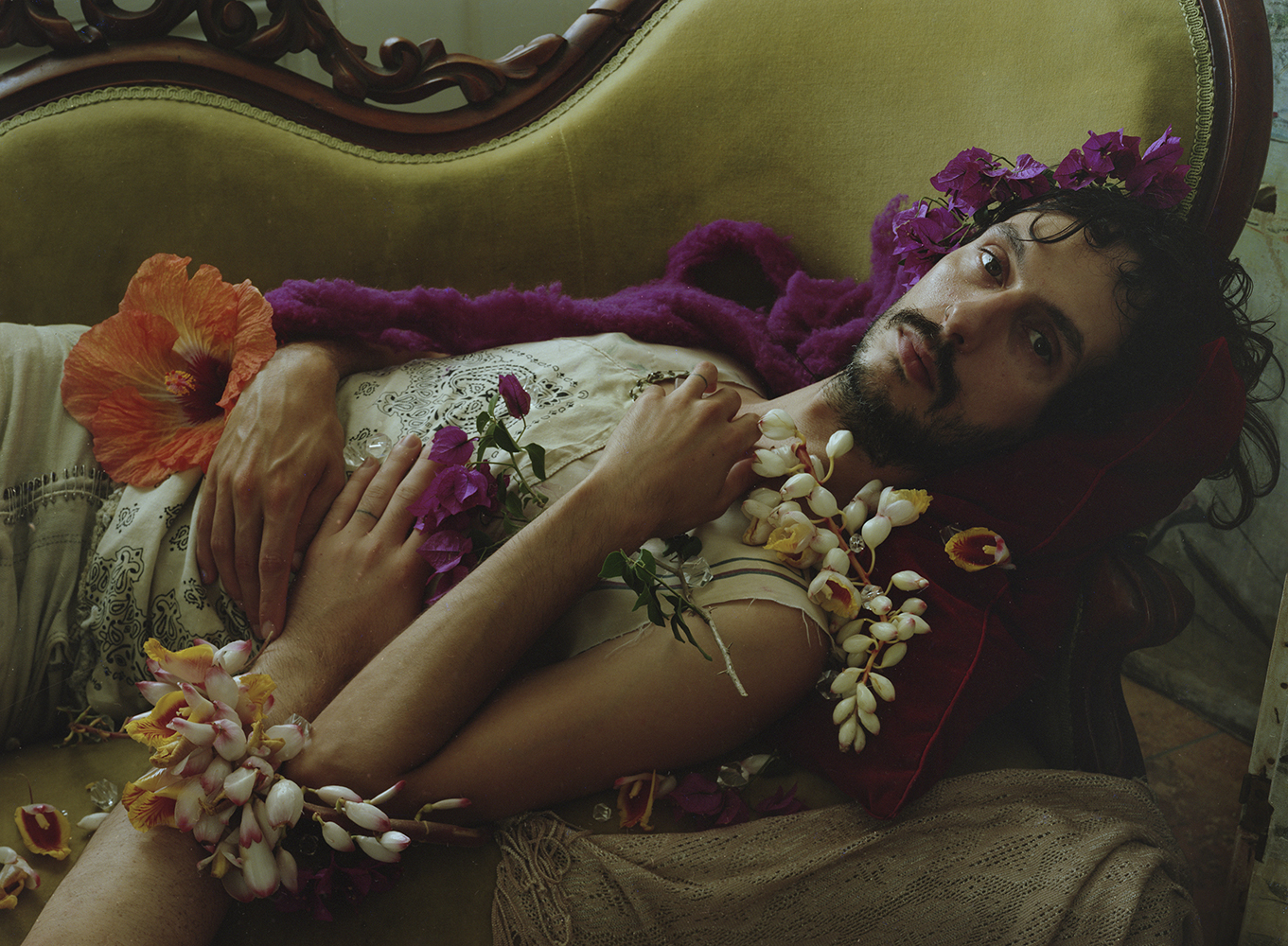
© Kristina Knipe, Whit and Colin During Quarantine
From the moment I first saw them, Kristina Knipe’s photographs captured my imagination. A kaleidoscope of opulent textures, colors, and materials, her images are lush visual landscapes that draw you in and invite you to get lost in the details. They are not only visually arresting; they are also emotionally compelling. While elaborately staged and often theatrical, Knipe’s portraits feel intimate and personal.
Many of the immersive compositions in Talisman are the epitome of excess and include objects with rich symbolic histories like crystals, hourglasses, and flowers. These are imbued with a sense of mystery, inviting you to imagine hidden messages waiting to be deciphered. Others possess a more haunting, narrative quality and an emptiness that suggests the most important part of the story has happened only moments before. Ultimately we are free to interpret these images on our own, elevated from passive observers to active participants in the stories they tell.
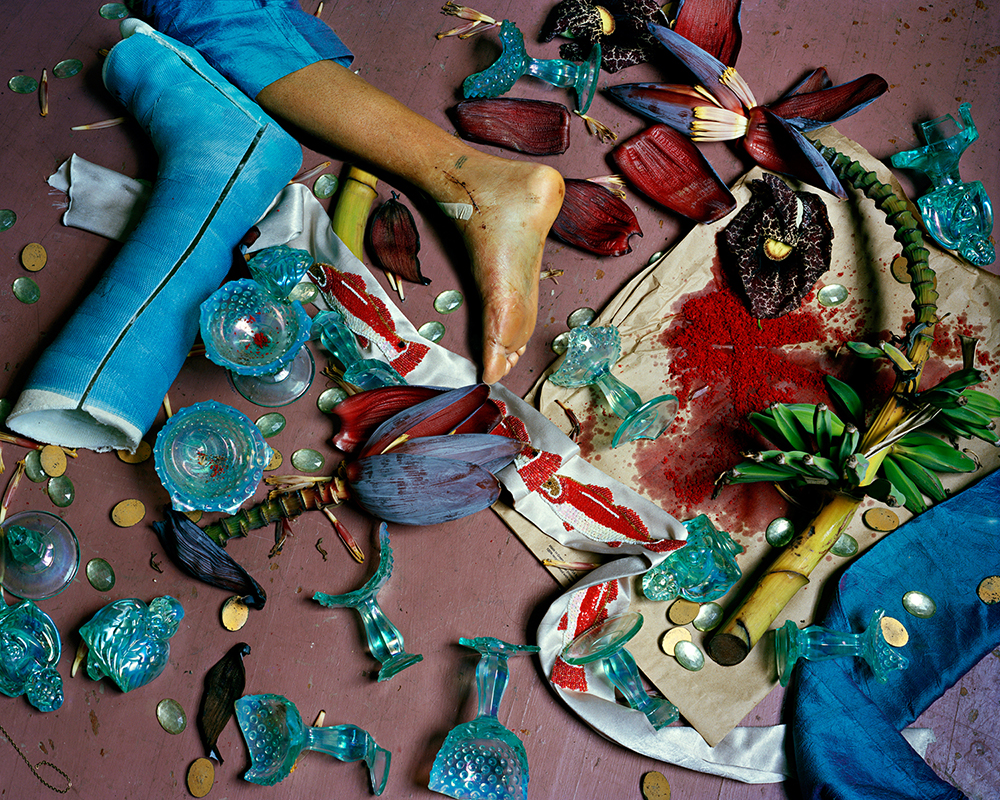
© Kristina Knipe, Soleil with Injury from Mardi Gras Day
Talisman
My roommate jumped out of a building on Mardi Gras day while rolling on ecstasy. She broke her ankle and spent that night in a hospital bed. I couldn’t be of any help as I had scratched my cornea with glitter. On Easter, a mended friend gave us a broken wheelchair to roll around the French Quarter chasing after Ostara and the Gay Easter Parade. To memorialize her injured ankle we arranged a tableau of broken goblets, molding banana blossoms, her old cast, and opulent detritus. Debauchery scars the body.
These 4×5 negatives offer details in excess–a rhinestone shimmering behind the wing of a dead cockroach, a cracked magnifying glass amplifies a passionflower, oxidation from a brass ring turns Antony’s finger green. To transgress the historic photographic ordering of society, I embrace mess and its attendant spectacle. Queer ritual disrupts engrained hierarchies, rejecting outmoded classifications. In New Orleans the altars, masquerades, and decadences create a visual and material excess that heals as it depletes. I adorn my sitters in our shared materials to create a transformative experience of pleasure.
The concrete reality of those I photograph consists of the burden of maintaining mental health without healthcare, of being a person whose role is to make other’s spaces beautiful which by necessity means repurposing objects for their own, of having traumatic experiences with no recourse, cycles of depression in the service of the hospitality industry, expressing gender and sexuality despite judgement, and persisting in generative work through loss. My story is intertwined with those I photograph- we cohabit spaces and experiences within a community of artists, activists, and healers. – Kristina Knipe
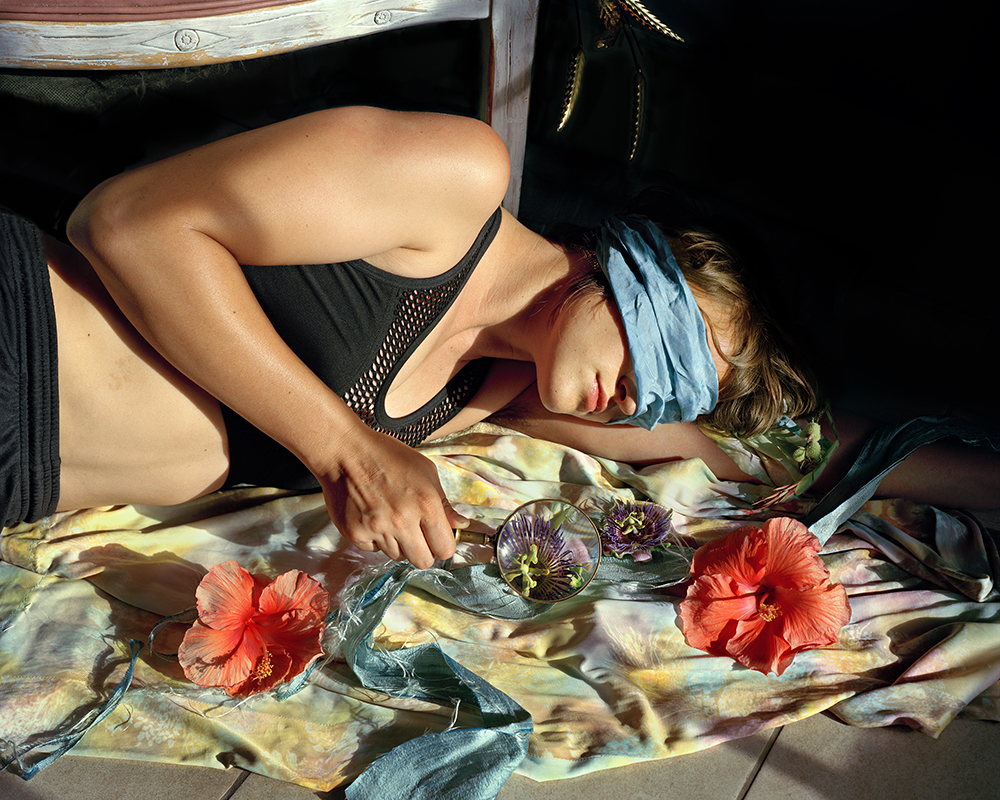
© Kristina Knipe, J with Hibiscus
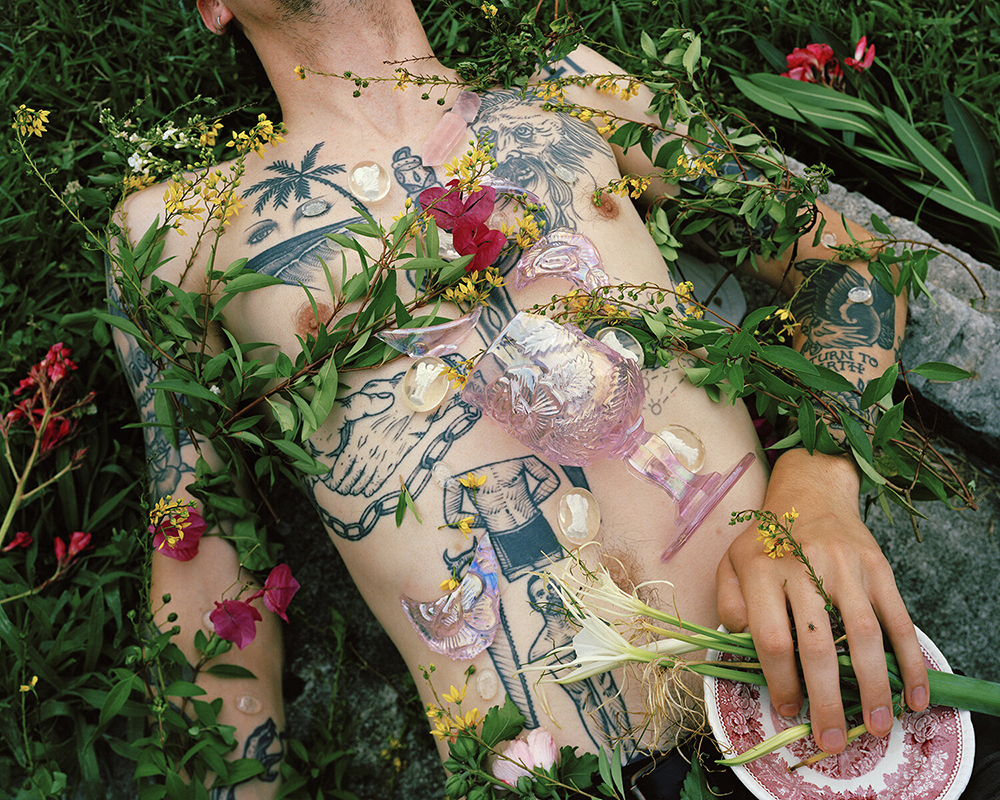
© Kristina Knipe, Jeremy with Broken Goblet and Angels
Kellye Eisworth: Where did the title Talisman come from? How does it frame the work?
Kristina Knipe: Talismans are objects that connect a person to their desire. One example is a rabbit’s foot- through wearing it or keeping it in their pocket, a person connects to their desire for luck. Desire, to me, is very visual. I express it through amplified light and color in my work.
As a title for this body of work, it frames our thinking about the connection between materials, magic, and desire.There is so much magic inherent in the process of photography. Light reflects off of materials, and through chemical processes creates an inscription on the color film I use.
Talisman is also a microcosm for what I am doing in my process. I think of the photographs I make as talismans- they are charged with symbols, and they are vessels that connect myself and the viewer to desire.
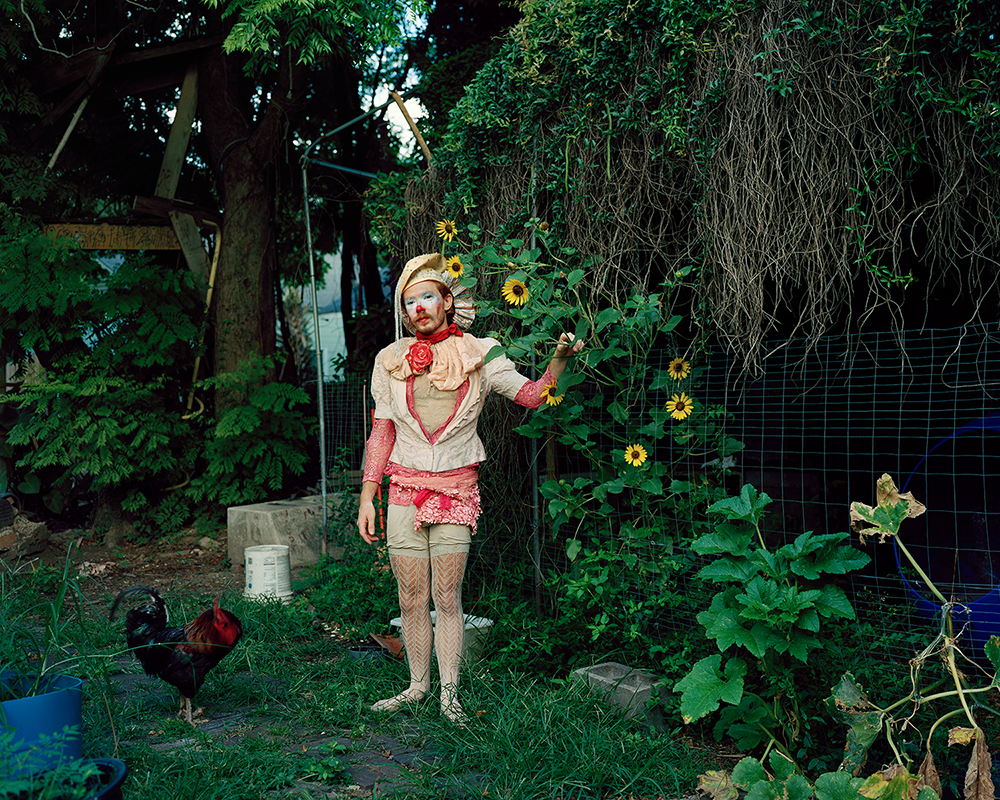
© Kristina Knipe, Nike in Ostara Costume at Dawn
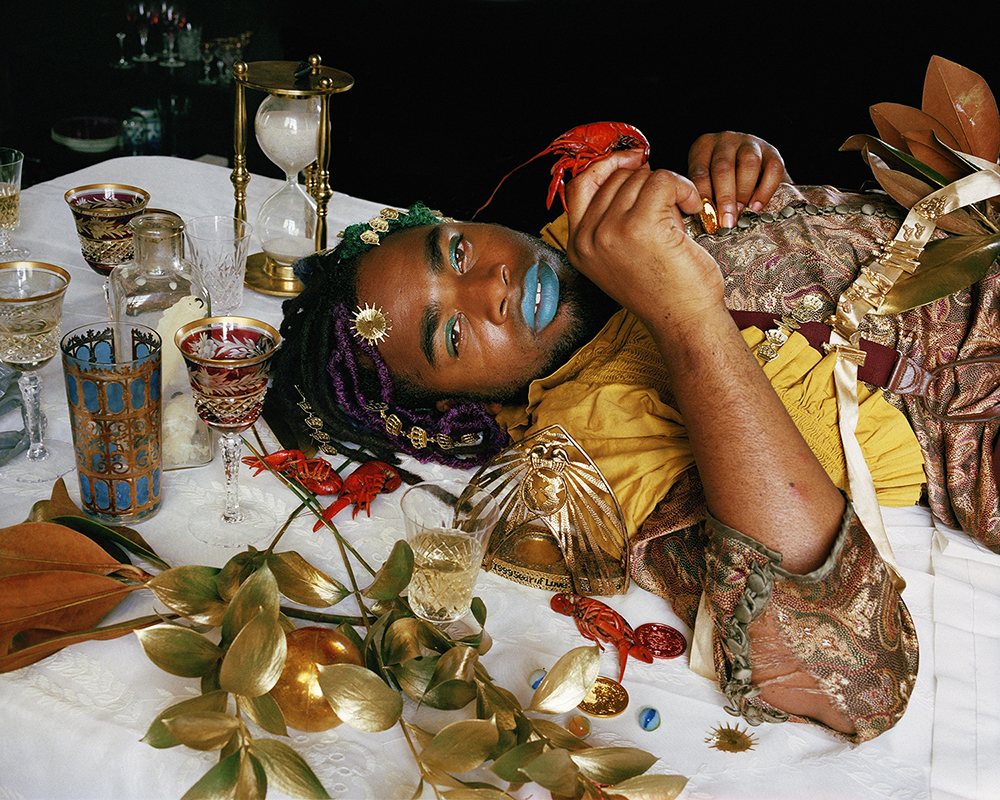
© Kristina Knipe, Daiquiri with Crawfish
KE: Your photographs have a very theatrical quality, with the subjects often costumed in elaborately staged environments. Do you see these as portraits of the specific person in the photograph, or more like actors performing a character?
KK: The photographs are very much portraits of a specific person, not actors performing a character. I really connect to Catherine Opie’s idea of creating a gallery of her own “royal family,” her community. I am attracted to people that have a rich interior life and express themselves visually with symbolism on their body like tattoos and fashion/costume, or through the objects they collect and create. The photographs reveal aspects of their identity and my connection to the subjects.
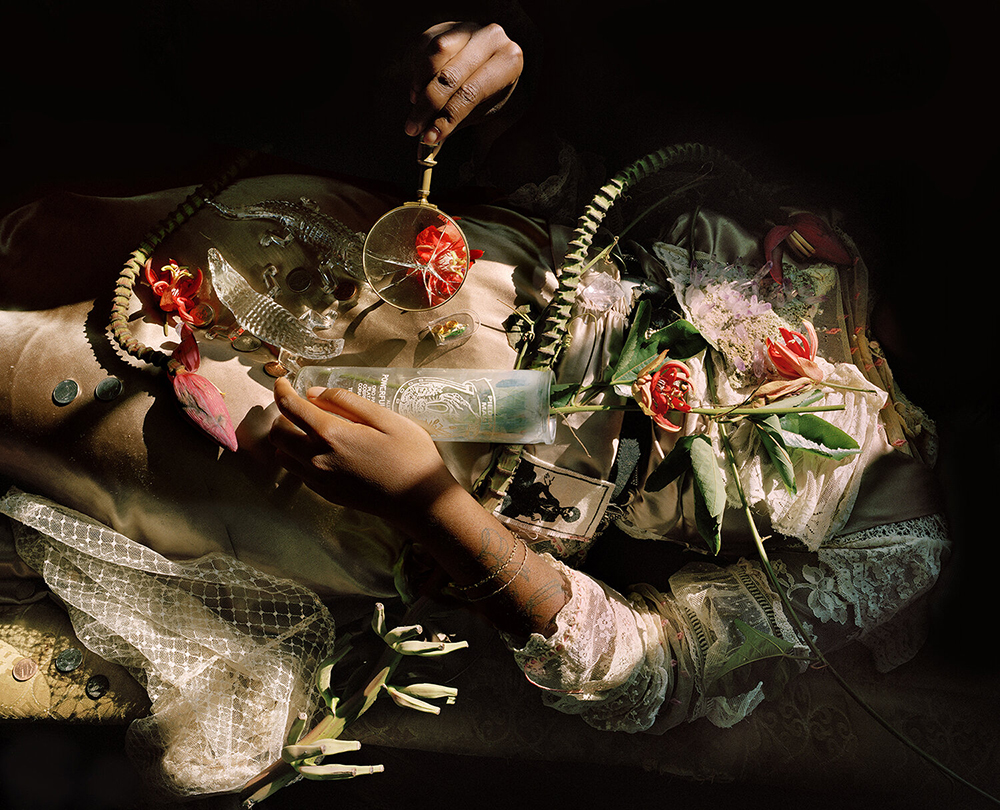
© Kristina Knipe, Erica Magnifying Passionflowers
KE: Many of your images remind me of classical Renaissance paintings. I’m thinking not only about portraits, but also of the vanitas or memento mori still-life paintings that featured objects encoded with specific symbolic meaning. Do the visual elements in your photographs contain a similar kind of symbolism?
KK: In New Orleans the altars, masquerades, and decadences create a visual and material excess. Some of the objects I depict can be used to heal while others deplete in a constant cycle. I am attracted to symbols of time passing, healing, magic, and objects that can be used in ritual practice. Quite a few of the images were collaborative, and my sitters bring their own objects and symbolism.
Vanitas and memento mori resonate with my work. I think of floral arrangements as a memorial to time and place, a symbol of both life and death. My friends and I gather all of the plant life in my work- nothing is purchased from a store. The process of gathering connects me to my city and brings the abundance of the seasons into my work.
Many of these images contain objects that are of sentimental importance to those I photograph- the objects carry a weight of meaning beyond how a viewer might interpret them within the image. Sentimentality itself is magic- we see something that others do not because we are imbuing the physical world with memory.
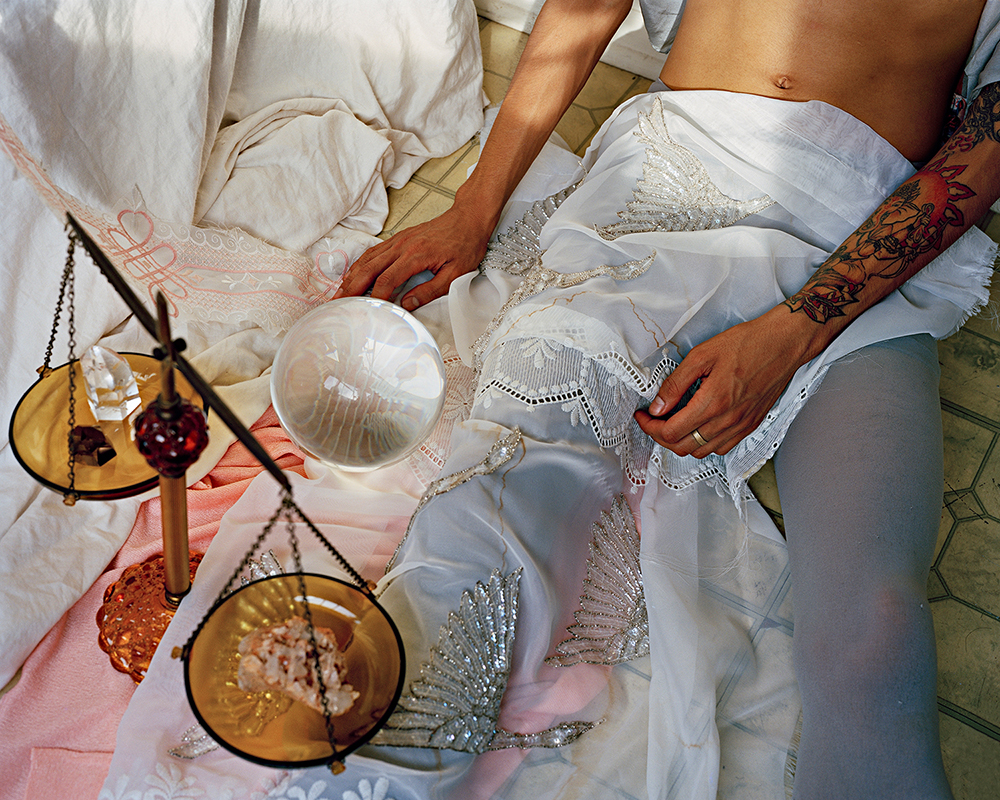
© Kristina Knipe, Antony and Seven Swans
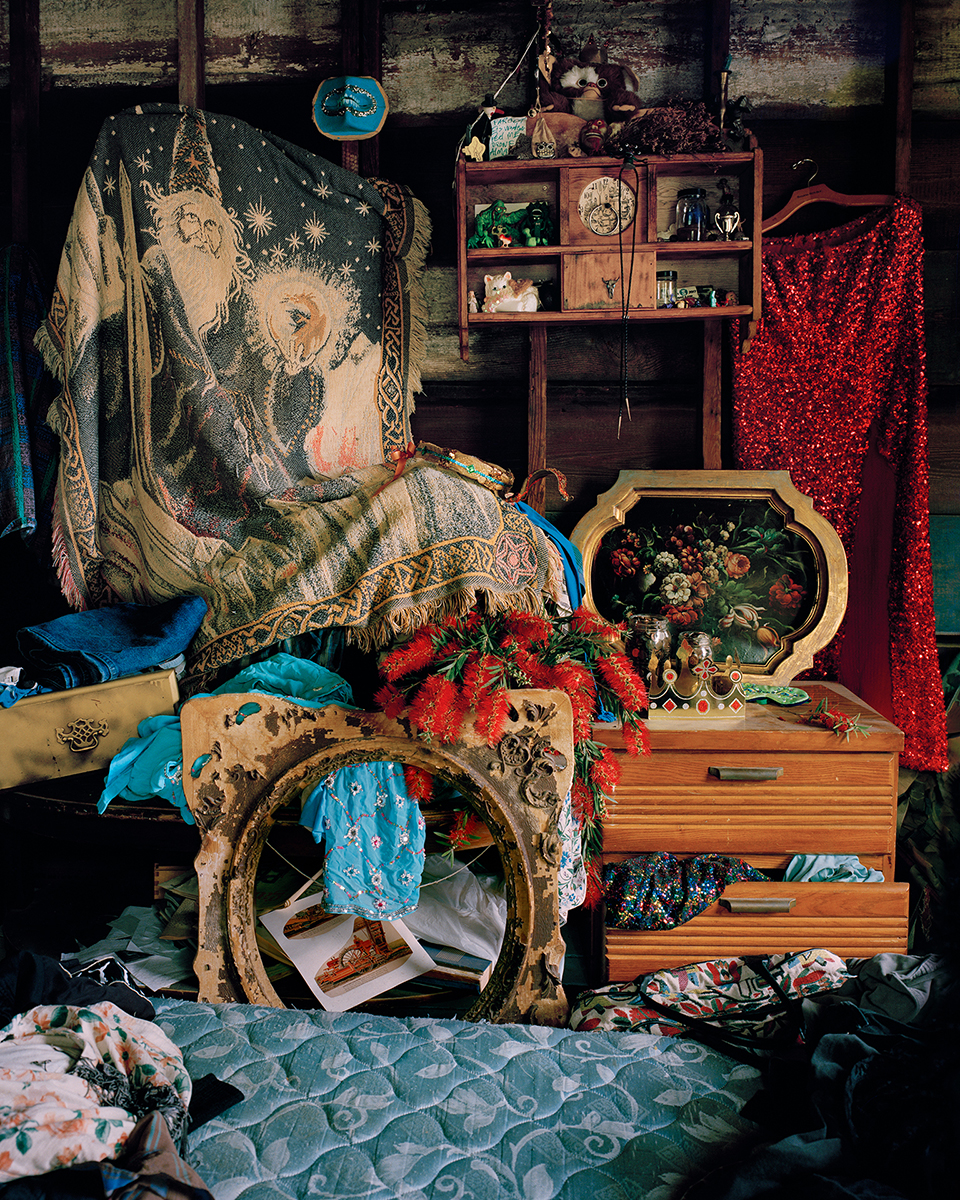
© Kristina Knipe, Auryn’s Shack
KE: How do the images of interiors relate to the portraits?
KK: My work is very personal and narrative. The interiors are all spaces where I have lived or spent a lot of time in. Auryn’s Shack is a shack on stilts that you have to climb up a ladder to get into. Once inside, it was this beautiful mess of objects, and a beautiful person lived there. To me, it always felt like a child’s dream made into physical form- an urban treehouse.
The interiors share symbolism with the portraits. Auryn’s shack is filled with treasures- glittering fabrics, tapestries, curios and figurines- and two crowns in the center of the composition. I often think about how folks in my community- specifically queer, femme, and poc- create a world within their homes that reflects them- a shelter from an outside world that is often inhospitable and sometimes violent to their bodies and souls. I identify with folks that put a lot of care into expressing themselves through their bodies and environments- another example is Erica’s Lamp, a photograph I made in my then housemate’s room. Burnt out 7-day candles are next to a beautiful lamp that is precariously balanced on a cinderblock. The tension of the lamp on the cinderblock relates to the images that have broken objects within them- such as the broken goblets in Soleil with Injury from Mardi Gras Day.
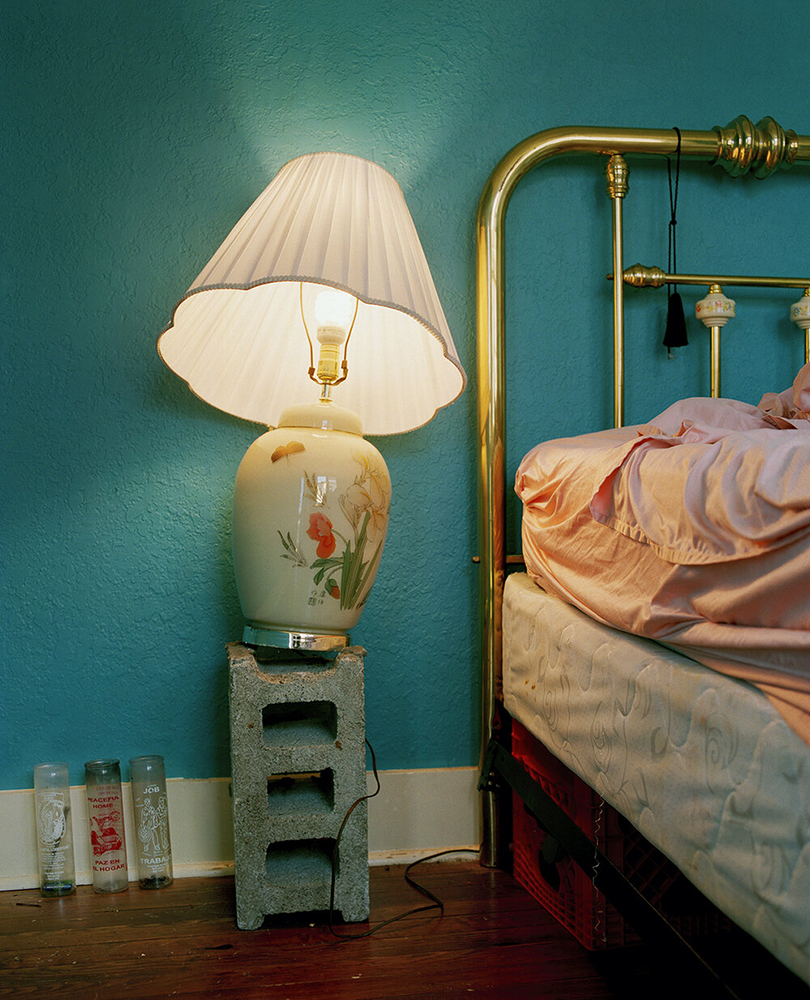
© Kristina Knipe, Erica’s Lamp
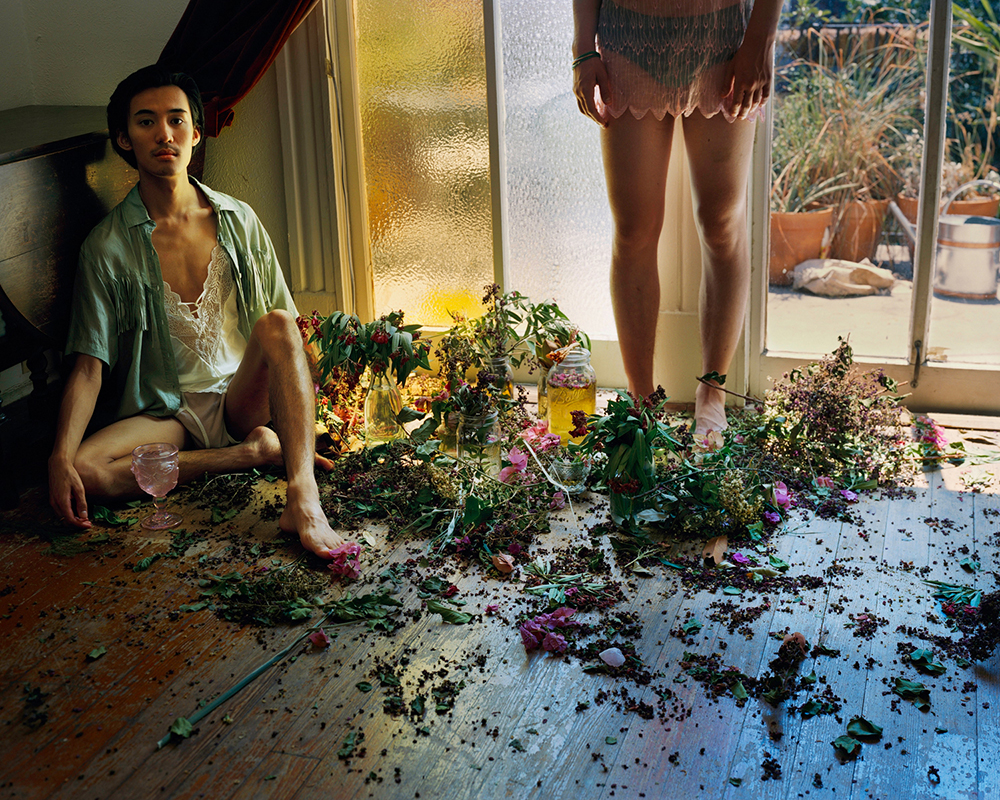
© Kristina Knipe, Antony and Zachary
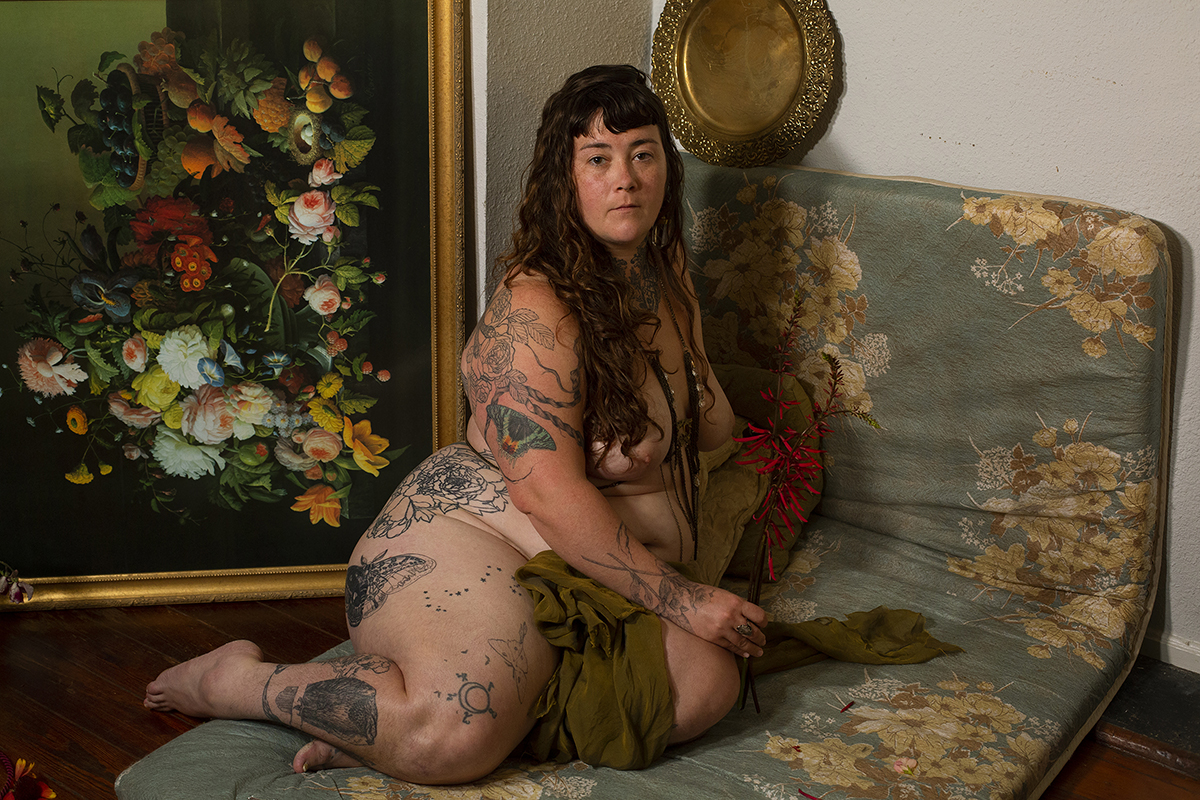
© Kristina Knipe, Shannon During Quarantine
KE: What motivated your choice to used a 4×5 camera to make these pictures? How did it effect your process and your interactions with the subjects?
KK: Slowing down allows for me and my sitter to connect and be comfortable. My shoots are meditative and intimate. I am conscious that many individuals hold trauma in their bodies and that the process of being photographed can be invasive, so I want to make sure that I am treating my subject with care. At times, the scenes I arrange can be quite layered, and I am managing many things at once. Since it is my aim that the objects/sitter/environment are all visually connected, sometimes objects are intentionally placed in precarious positions.
On a practical note, I shoot 4×5 so that I can print large with a precision of detail. I love being able to see the red eyes of the fly on Jeremy’s hand, the dust on the dresser in Auryn’s shack, the stains on the lace draped over Antony. Under the dark cloth with my eye up the loupe, I marvel at the beauty of these small details and the magic of an image surfacing on the ground glass.

© Kristina Knipe, Mike’s Car
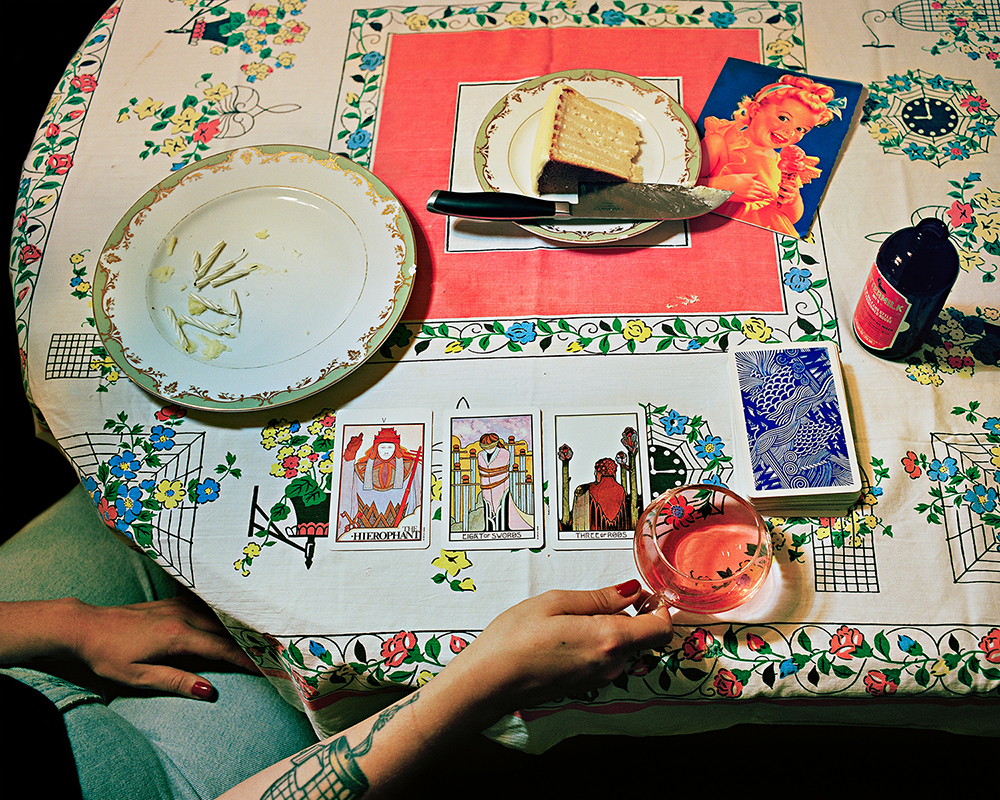
© Kristina Knipe, Whitney’s 29th Birthday
Kristina Knipe is an artist and educator who makes photographs, videos, books, and installations. Through a variety of approaches, her work examines how objects, symbols, spaces and the body function as markers of identity. She considers art making a healing practice, which can catalyze healing with others. Kristina earned her BFA at NYU Tisch School of the Arts in 2012 and her MFA from Tulane University in 2016. She is the 2020 recipient of the Clarence John Laughlin Award. Her work has been exhibited in the Ogden Museum of Southern Art, The Contemporary Art Center of NewOrleans, SF Camera Work, The Center for Photography at Woodstock, and numerous artist-run collective spaces in New Orleans, Louisiana. She is a member of Only Connect Collective and Staple Goods Collective.
Follow her on Instagram: @kristiknipe
Posts on Lenscratch may not be reproduced without the permission of the Lenscratch staff and the photographer.
Recommended
-
Tara Sellios: Ask Now the BeastsApril 6th, 2024
-
ALEXIS MARTINO: The Collapsing Panorama April 4th, 2024
-
Emilio Rojas: On Gloria Anzaldúa’s Borderlands: The New MestizaMarch 30th, 2024
-
Artists of Türkiye: Eren SulamaciMarch 27th, 2024
-
Love and Loss in the Cosmos: Valeria Sestua In Conversation with Vicente IsaíasMarch 19th, 2024



























































